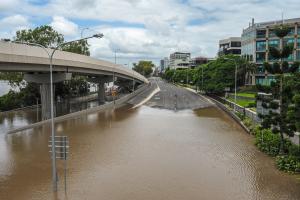Floodproofing A Home: Effective Solutions for Coastal Areas
Floodproofing involves implementing systems and techniques designed to minimize the impact of flooding, whether from storm surges, heavy rainfall, or overflow from nearby water sources.”
HAMMOND, LA, UNITED STATES, January 15, 2025 /EINPresswire.com/ -- Flooding is a constant risk for homeowners in coastal regions, where heavy rains, hurricanes, and rising sea levels threaten property and infrastructure. Effective floodproofing strategies are essential to protect homes, reduce damage, and ensure long-term resilience against water intrusion. Earl Carr, Jr.2, president of Gulf 521 in Hammond, Louisiana, emphasizes the importance of proactive measures and tailored solutions to address the unique challenges faced by coastal properties.— Earl Carr, Jr.
"Floodproofing involves implementing systems and techniques designed to minimize the impact of flooding, whether from storm surges, heavy rainfall, or overflow from nearby water sources. With careful planning, these measures can safeguard both the structure of a home and its contents, reducing repair costs and improving safety," explains Carr Jr.
Types of Floodproofing Solutions
Floodproofing strategies can be broadly categorized into two approaches: wet floodproofing and dry floodproofing. Each method offers specific benefits depending on the property’s location, elevation, and flood risk.
1. Wet Floodproofing
Wet floodproofing involves making a property more resilient to floodwaters by allowing water to enter and exit the building without causing significant damage. Key techniques include:
Installing Flood Vents: These vents allow water to flow freely through the foundation, equalizing pressure and preventing structural damage.
Using Water-Resistant Materials: Materials like concrete, tile, and pressure-treated wood are less prone to water damage and mold growth.
Elevating Electrical Systems: Placing electrical outlets, switches, and HVAC equipment above expected flood levels reduces the risk of damage.
Raising Appliances and Utilities: Elevating items like water heaters and washers/dryers on platforms helps protect them from floodwater.
Wet floodproofing is often suitable for areas prone to shallow flooding, where water levels are expected to rise temporarily without significant surges.
2. Dry Floodproofing
Dry floodproofing aims to prevent water from entering the property altogether. This approach is typically used for structures that are not located in high-risk flood zones or can be effectively sealed. Common techniques include:
Sealing Walls and Foundations: Applying waterproof coatings and sealants to walls and foundations creates a barrier against water intrusion.
Installing Flood Barriers: Portable or permanent barriers can be placed around doors, windows, and other openings to block floodwater.
Using Backflow Valves: Installing backflow valves in plumbing prevents floodwaters from backing up into the property through drains and toilets.
Reinforcing Entry Points: Waterproof doors and windows with durable seals provide additional protection against water entry.
Dry floodproofing is most effective for buildings located above base flood elevation or those designed to withstand occasional flooding.
Elevating Structures: A Long-Term Solution
In areas with frequent or severe flooding, elevating the entire structure is a long-term solution that provides substantial protection. By raising the property above the base flood elevation, the risk of water damage is significantly reduced.
Techniques for elevation include:
Pier and Beam Foundations: Raising the property on piers or beams creates open space underneath, allowing floodwaters to pass without affecting the structure.
Fill and Slab Construction: Adding fill material beneath the foundation raises the structure, keeping it above potential flood levels.
Extended Stairs and Access Points: Elevated properties require modifications to entry points, including stairs, ramps, and elevated walkways.
While elevation involves upfront costs, it offers long-term benefits in reduced damage, lower insurance premiums, and improved property value.
Improving Drainage and Landscaping
Effective drainage systems and landscaping modifications can reduce the risk of flooding around a property. Solutions include:
Installing French Drains: These underground drainage systems redirect water away from the foundation.
Grading the Yard: Sloping the ground away from the property directs rainwater and runoff toward designated drainage areas.
Using Rain Gardens: Planting rain gardens with water-absorbing plants reduces surface water accumulation and improves drainage.
Maintaining Gutters and Downspouts: Ensuring gutters and downspouts are clear of debris and properly positioned prevents water from pooling near the foundation.
Flood Insurance and Compliance
Floodproofing measures can impact flood insurance rates and compliance with local building codes. Many municipalities and insurance providers offer incentives for properties that meet or exceed floodplain management standards.
Common benefits include:
Reduced Premiums: Elevating structures or installing approved floodproofing systems may qualify for insurance discounts.
Code Compliance: Meeting or exceeding building codes ensures that the property is prepared for future flooding and avoids potential penalties.
Understanding the requirements of the National Flood Insurance Program (NFIP) and local regulations is critical when planning floodproofing projects.
The Risks of Inaction
Failing to implement floodproofing measures increases the likelihood of significant damage during flood events. Common consequences include:
Structural Damage: Floodwater can weaken foundations, walls, and flooring, compromising the safety of the building.
Mold Growth: Prolonged moisture exposure leads to mold, which can cause health issues and expensive remediation.
Financial Losses: Repair costs, loss of personal belongings, and higher insurance premiums can add up quickly after a flood.
Proactive floodproofing reduces these risks, offering peace of mind and long-term savings.
Solutions for Coastal Communities
For properties in coastal areas, floodproofing is an essential investment in resilience and protection. Tailored solutions, combined with ongoing maintenance, provide the best defense against the unique challenges posed by flooding.
By addressing vulnerabilities and implementing effective strategies, property owners can reduce the impact of future floods and safeguard their investments.
About Gulf 52
Gulf 52, based in Hammond, Louisiana, specializes in disaster mitigation, restoration, and construction services. With decades of experience, the company provides tailored solutions for floodproofing, water damage restoration, and other challenges faced by residential and commercial properties in coastal areas.
Morgan Thomas
Rhino Digital, LLC
+1 504-875-5036
email us here
Visit us on social media:
Facebook
1 https://gulf52.com
2 https://gulf52.com


